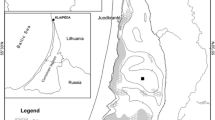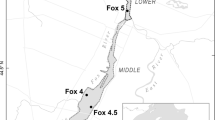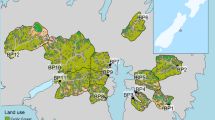Abstract
The Lower Havel in Berlin is a polymictic riverine lake, thermally stratified for some days or weeks in summer. It is characterized by a relatively high mean total phosphorus concentration (145 µg l−1) and frequent cyanobacteria mass development in summer. We quantified the potentially mobile P pool in sediments, determined P fluxes based on conventional dialysis sampler-, gel probe- and benthic chamber measurements, and combined this with column experiments and P budget calculations to evaluate whether a) a reduction of P loading would be counterbalanced by P release from sediment, and b) release of redox sensitive P would even increase with reduction of nitrogen loading. The potentially mobile P pool was relatively small (228 t) compared to mean annual external load (190 t a−1) and gross P release (1.2–36 mg m−2 day−1), and was thus of little relevance for long-term P availability. Despite 38 % of P in the sediment being redox sensitive, the seasonal course of P gross release was mainly driven by redox independent organic matter mineralization of diagenetically young surface sediment. Under anoxic conditions, P release was higher than under oxic conditions and to some extent controlled by nitrate under laboratory conditions. However, ambient nitrate availability was too low to affect P release which was more dependent on mineralization and Fe availability than on redox. Therefore, the Lower Havel would benefit from P load reduction but internal P loading would be largely unaffected from further N load reduction.











Similar content being viewed by others
References
Andersen JM (1976) An ignition method for determination of total phosphorus in lake sediments. Water Res 10:329–331
Andersen JM (1982) Effect of nitrate concentration in lake water on phosphate release from the sediment. Water Res 16:1119–1126
Berg P, Risgaard-Petersen N, Rysgaard S (1998) Interpretation of measured concentration profiles in sediment pore water. Limnol Oceanogr 43:1500–1510
Burger D, Hamilton DP, Pilditch CA, Gibbs MM (2007) Benthic nutrient fluxes in a eutrophic, polymictic lake. Hydrobiologia 584:13–25
Callender E, Hammond DE (1982) Nutrient exchange across the sediment–water interface in the Potomac River estuary. Estuar Coast Shelf S 15:395–413
Canfield DE (1989) Reactive iron on marine sediments. Geochim Cosmochim Acta 53:619–632
Caraco NF, Cole JJ, Likens GE (1989) Evidence for sulfate-controlled phosphorus release from sediments of aquatic systems. Nature 341:316–318
Clavero V, Izquierdo JJ, Fernandez JA, Niell FX (2000) Seasonal fluxes of phosphate and ammonium across the sediment–water interface in a shallow small estuary (Palmones River, southern Spain). Mar Ecol Prog Ser 198:51–60
DIN 38 406 E5 (1983) German standard methods for the examination of water, waste water and sludge; cations (group E); determination of ammonia-nitrogen (E 5). Deutsches Institut für Normung e.V., Berlin
DIN EN ISO 6878 (2004) Water quality- determination of phosphorus- ammonium molybdate spectrometric method. European Committee for Standardization, Brussels
Fossing H, Jorgensen BB (1989) Measurement of bacterial sulfate reduction in sediments- evaluation of a single-step chromium reduction method. Biogeochemistry 8:205–222
Foy RH (1986) Suppression of phosphorus release from lake sediments by the addition of nitrate. Water Res 20:1345–1351
Gabriel O, Balla D, Kalettka T, Schilling C, Zessner M (2006) Estimating the influence of increased nitrate loads from wastewater on phosphorus mobility in river sediments. Acta Hydrochim Hydrobiol 34:333–345
Gerke J (1993) Phosphate adsorption by humic/Fe-oxide mixtures aged at pH 4 and 7 and by poorly ordered Fe-oxide. Geoderma 59:279–288
Golterman H (2004) The chemistry of phosphate and nitrogen compounds in sediments. Kluver, Dordrecht
Grüneberg B, Kleeberg A (2005) Benthic phosphorus forms and transformations during neutralization of acid mining lakes. In: Serrano L, Golterman H (eds) Phosphates in sediments. Backhuys Publishers, Leiden, pp 127–137
Grüneberg B, Rücker J, Nixdorf B, Behrendt H (2011) Dilemma of non-steady state in lakes—development and predictability of in-lake P concentration in dimictic Lake Scharmutzelsee (Germany) after abrupt load reduction. Int Rev Hydrobiol 96:599–621
Gunnars A, Blomqvist S, Johansson P, Andersson C (2002) Formation of Fe(III) oxyhydroxide colloids in freshwater and brackish seawater, with incorporation of phosphate and calcium. Geochim Cosmochim Acta 66:745–758
Hamilton SK (2012) Biogeochemical time lags may delay responses of streams to ecological restoration. Freshw Biol 57:43–57
Hemond HF, Lin K (2010) Nitrate suppresses internal phosphorus loading in an eutrophic lake. Water Res 44:3645–3650
Herzsprung P, Schultze M, Hupfer M, Boehrer B, von Tümpling W, Duffek A Jr, Van der Veen A, Friese K (2010) Flood effects on phosphorus immobilisation in a river water filled pit lake–case study Lake Goitsche (Germany). Limnologica 40:182–190
Hesslein RH (1976) An in situ sampler for close interval pore water studies. Limnol Oceanogr 21:912–914
Höhne L (1995) Entwicklung der Eutrophierung von Spree und Havel im Zeitraum von 1955–1990. Die Havel. Landesumweltamt Brandenburg, pp 33–37
House WA (2003) Geochemical cycling of phosphorus in rivers. Appl Geochem 18:739–748
Hsieh YP, Yang CH (1989) Diffusion methods for the determination of reduced inorganic sulfur species in sediments. Limnol Oceanogr 34:1126–1129
Hupfer M, Lewandowski J (2005) Retention and early diagenetic transformation of phosphorus in Lake Arendsee (Germany)—consequences for management strategies. Arch Hydrobiol 164:143–167
Hupfer M, Lewandowski J (2008) Oxygen controls the phosphorus release form lake sediments—a long-lasting paradigm in limnology. Int Rev Hydrobiol 93:415–432
Jarvie HP, Jürgens MD, Williams RJ, Neal C, Davies JJL, Barrett C, White J (2005) Role of river bed sediments as sources and sinks of phosphorus across two major eutrophic UK river basins: the Hampshire Avon and Herefordshire Wye. J Hydrol 304:51–74
Jensen HS, Andersen FO (1992) Importance of temperature, nitrate, and pH for phosphate release from aerobic sediments of four shallow, eutrophic lakes. Limnol Oceanogr 37:577–589
Jensen HS, Kristensen P, Jeppesen E, Skytthe A (1992) Iron:phosphorus ratio in surface sediment as an indicator of phosphate release from aerobic sediment in shallow lakes. Hydrobiologia 235:731–743
Jensen K, Sloth NP, Risgaardpetersen N, Rysgaard S, Revsbech NP (1994) Estimation of nitrification and denitrification from microprofiles of oxygen and nitrate in model sediment systems. Appl Environ Microbiol 60:2094–2100
Jensen JP, Pedersen AR, Jeppesen E, Sondergaard M (2006) An empirical model describing the seasonal dynamics of phosphorus in 16 shallow eutrophic lakes after external load reduction. Limnol Oceanogr 51:791–800
Jeppesen E, Sondergaard M, Jensen JP, Havens KE, Anneville O, Carvalho L, Coveney MF, Deneke R, Dokulil MT, Foy B, Gerdeaux D, Hampton SE, Hilt S, Kangur K, Kohler J, Lammens EHHR, Lauridsen TL, Manca M, Miracle MR, Moss B, Noges P, Persson G, Phillips G, Portielje R, Schelske CL, Straile D, Tatrai I, Willen E, Winder M (2005) Lake responses to reduced nutrient loading—an analysis of contemporary long-term data from 35 case studies. Freshw Biol 50:1747–1771
Jørgensen SE (1976) A eutrophication model for a lake. Ecol Model 2:147–165
Jørgensen SE, Kamp-Nielsen L, Jacobsen OS (1975) A submodel for anaerobic mud-water exchange of phosphate. Ecol Model 1:133–146
Kleeberg A, Dudel GE (1997) Changes in extent of phosphorus release in a shallow lake (Lake Großer Müggelsee, Germany, Berlin) due to climatic factors and load. Mar Geol 139:61–75
Kleeberg A, Kozerski HP (1997) Phosphorus release in lake Grosser Müggelsee and its implications for lake restoration. Hydrobiologia 342:9–26
Kleeberg A, Herzog C, Hupfer M (2013) Redox sensitivity of iron in phosphorus binding does not impede lake restoration. Water Res 47:1491–1502
Kneis D, Knoesche R, Bronstert A (2006) Analysis and simulation of nutrient retention and management for a lowland river-lake system. Hydrol Earth Syst Sci 10:575–588
Knösche R (2006) Nährstoffaushagerung von Flusssee-Sedimenten. In: Bronstert A, Itzerott S (eds) Bewirtschaftungsmöglichkeiten im Einzugsgebiet der Havel. Mathematisch-Naturwissenschaftliche Fakultät der Universität Potsdam, Potsdsam, Abschlussberichtsbericht zum BMBF-Projekt, pp 1–74
Krom MD, Davison P, Zhang H, Davison W (1994) High-resolution pore-water sampling with a gel sampler. Limnol Oceanogr 39:1967–1972
Lehtoranta J, Heiskanen AS (2003) Dissolved iron:phosphate ratio as an indicator of phosphate release to oxic water of the inner and outer coastal Baltic Sea. Hydrobiologia 492:69–84
Lewandowski J (2002) Untersuchungen zum Einfluss seeinterner Verfahren auf die Phosphor-Diagenese in Sedimenten. Dissertation, Humbold-Universität Berlin
Lewandowski J, Rüter K, Hupfer M (2002) Two dimensional small-scale variability of pore water phosphate in freshwater lakes: results from a novel dialysis sampler. Environ Sci Technol 36:2039–2047
Lewandowski J, Schauser I, Hupfer M (2003) Long term effects of phosphorus precipitations with alum in hypereutrophic Lake Süsser See (Germany). Water Res 37:3194–3204
Maaßen S (2003) Vergleichende Untersuchungen über den potentiellen Eintrag von Nährstoffen in den Wasserkörper von Talsperren durch Freisetzung aus dem Sediment. Dissertation, Fakultät Mathematik und Naturwissenschaften der Technischen Universität Dresden
Maaßen S, Uhlmann D, Röske I (2005) Sediment and pore water composition as a basis for the trophic evaluation of standing waters. Hydrobiologia 543:55–70
Nützmann G, Wolter C, Venohr M, Pusch M (2011) Historical patterns of anthropogenic impacts on freshwaters in the Berlin-Brandenburg Region. Erde 142:41–64
Petzoldt T, Uhlmann D (2006) Nitrogen emissions into freshwater ecosystems: is there a need for nitrate elimination in all wastewater treatment plants? Acta Hydrochim Hydrobiol 34:305–324
Psenner R, Pucsko R, Sager M (1984) Die Fraktionierung organischer und anorganischer Phosphorverbindungen von Sedimenten - Versuch einer Definition ökologisch wichtiger Faktoren. Arch Hydrobiol Beih 70:111-155
Raiswell R, Canfield DE, Berner RA (1994) A comparison of iron extraction methods for the determination of degree of pyritisation and the recognition of iron-limited pyrite formation. Chem Geol 111:101–110
Reitzel K, Hansen J, Andersen FO, Hansen KS, Jensen HS (2005) Lake restoration by dosing aluminum relative to mobile phosphorus in the sediment. Environ Sci Technol 39:4134–4140
Ripl W, Lindmark GK (1978) Ecosystem control by nitrogen metabolism in sediment. Vatten 34:135–144
Rohde E (1995) Zur Problematik der Phosphorfreisetzung aus den Sedimenten der Potsdamer Havelseen. Die Havel. Landesumweltamt Brandenburg, pp 57–60
Rothe M, Frederichs T, Eder M, Kleeberg A, Hupfer M (2014) Evidence for vivianite formation and its contribution to long-term phosphorus retention in a recent lake sediment: a novel analytical approach. Biogeosciences 11:5169–5180
Sas H (1989) Lake restoration by reduction of nutrient loading. Expectations, experiences, extrapolations. Academia-Verl Richarz, Sankt Augustin
Schauser I, Chorus I, Lewandowski J (2006) Effects of nitrate on phosphorus release: comparisons of two Berlin lakes. Acta Hydrochim Hydrobiol 34:325–332
Selig U, Schlungbaum G (2002) Longitudinal patterns of phosphorus and phosphorus binding in sediment of a lowland lake-river system. Hydrobiologia 472:67–76
Sinke AJC, Cornelese AA, Keizer P, van Tongeren OFR, Cappenberg ThE (1990) Mineralisation, pore water chemistry and phosphorus release from peaty sediments in the eutrophic Loosdrecht lakes, The Netherlands. Freshw Biol 23:587–599
Sondergaard M, Jensen JP, Jeppesen E (1999) Internal phosphorus loading in shallow Danish lakes. Hydrobiologia 408(409):145–152
Sondergaard M, Jeppesen E, Jensen JP (2000) Hypolimnetic Nitrate Treatment to Reduce Internal Phosphorus Loading in a Stratified Lake. Lake Reserv Manage 16:195–204
Sondergaard M, Jensen JP, Jeppesen E (2003) Role of sediment and internal loading of phosphorus in shallow lakes. Hydrobiologia 506:135–145
Sondergaard M, Bjerring R, Jeppesen E (2013) Persistent internal phosphorus loading during summer in shallow eutrophic lakes. Hydrobiologia 710:95–107
Tessenow U (1974) Lösungs-, Diffusions- und Sorptionsprozesse in der Oberschicht von Seesedimenten IV. Reaktionsmechanismen und Gleichgewichte im System Eisen- Mangan-Phosphat. Arch Hydrobiol Suppl 47:1–79
Thamdrup B, Glud RN, Hansen JW (1994) Manganese oxidation and in situ manganese fluxes from a coastal sediment. Geochim Cosmochim Acta 58:2563–2570
Urban NR, Dinkel C, Wehrli B (1997) Solute transfer across the sediment surface of a eutrophic lake: I. Porewater profiles from dialysis samplers. Aquat Sci 59:1–25
Wauer G, Gonsiorczyk T, Casper P, Koschel R (2005a) P-immobilisation and phosphatase activities in lake sediment following treatment with nitrate and iron. Limnologica 35:102–108
Wauer G, Gonsiorczyk T, Kretschmer K, Casper P, Koschel R (2005b) Sediment treatment with a nitrate-storing compound to reduce phosphorus release. Water Res 39:494–500
Welch EB, Cooke GD (2005) Internal phosphorus loading in shallow lakes: importance and control. Lake Reserv Manage 21:209–217
Wolter KD (2004) Nachhaltige Entwicklung - Prozessbetrachtung und Konsequenzen für die Ökosystemsteuerung am Beispiel der Seerestaurierung. Technische Universiät Berlin, Institut für Ökologie, Habilitation
Acknowledgments
We sincerely thank all persons who directly or indirectly contributed to this study. Ingo Henschke, Thomas Wolburg and Dagmar Steubing helped in lake sampling. Sabine Natusch, Ute Abel and Gudrun Lippert performed chemical analysis at the BTUC, and Dagmar Steubing and Simone Troßen at the BfG. Annette Becker supplied sediment samples and basic data of the 2014 mapping. We thank Kurt Friese from the UFZ Magdeburg for providing lab facilities for sulfur analysis. Water quantity and quality data where supplied by the Berlin Senate Department for Urban Development and the Environment. We thank Thomas Petzoldt, Brigitte Nixdorf, David Kneis and Andrew Dolman for statistics support and helpful comments on the manuscript. This work was performed as part of the research project NITROLIMIT and funded by the framework program Research for Sustainable Development (Grant Number: 033L041A) of the German Federal Ministry of Education and Research.
Author information
Authors and Affiliations
Corresponding author
Additional information
Responsible Editor: James Sickman.
Rights and permissions
About this article
Cite this article
Grüneberg, B., Dadi, T., Lindim, C. et al. Effects of nitrogen and phosphorus load reduction on benthic phosphorus release in a riverine lake. Biogeochemistry 123, 185–202 (2015). https://doi.org/10.1007/s10533-014-0062-3
Received:
Accepted:
Published:
Issue Date:
DOI: https://doi.org/10.1007/s10533-014-0062-3




